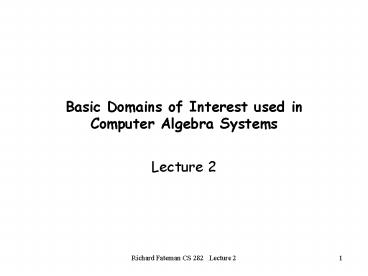Basic Domains of Interest used in Computer Algebra Systems PowerPoint PPT Presentation
1 / 14
Title: Basic Domains of Interest used in Computer Algebra Systems
1
Basic Domains of Interest used in Computer
Algebra Systems
- Lecture 2
2
We can compute with any finitely representable
objects, at least in principle
- Objects from any algebraic system, and even some
ad-hoc mixtures - With any algorithms
- All steps specified precisely
- Terminating
- Some processes are not-necessarily terminating.
E.g. Lhôpitals rule use termination
heuristics time/space limits, losing some
credibility for results ? - But we tend to concentrate on domains that occur
in applied math, physical sciences, etc.
3
The Usual Operations
- Integer and Rational
- Ring and Field operations - exact quotient,
remainder - GCD, factoring of integers
- Approximation via rootfinding
- Polynomial operations
- Ring, Field, GCD, factor
- Truncated power series
- Solution of polynomial systems
- Matrix operations (add determinant, resultant,
eigenvalues, etc.)
4
More Operations
- Sorting (e.g. of monomials)
- Union (collections)
- Tests for zero
- Extraction of parts (polynomial degree, constant
coefficient, leading coefficient) - Conversion to different forms (expand, express
algebraic function in a minimal extension,
simplify)
5
Yet More Operations
- Differentiate
- Integrate
- Limit
- Prove
- Find region in which (in)equalities hold
- Confirm (as steps in a proof)
- Expand in series
6
Yet More Operations
- Plot
plot3d(exp(-x2-y2)x,x,-2,2,y,-1.5,2.5)
7
Yet More Operations
- Typesetting
8
Integer representations, operations
- The ring operations -
- Euclidean Domain quotient remainder, GCD
- UFD factorization
9
Unfortunately computers dont do these operations
directly
- Addition modulo 231-1 is rarely what we
need. - How do we do arbitrary precision integer
arithmetic? (If we could do this, we could build
the rationals, and via intervals or some other
construction, we could make reals)
10
Is it hard to do arbitrary integer (bignum)
arithmetic?
- In spite of your knowledge of this subject, there
are subtleties, especially in long division! - You must choose fast algorithms (moderate size)
or asymptotically optimal algorithms (large
size) whats your target?
11
Who cares about integer arithmetic?
- You need fast long arithmetic to compute billions
of digits of p e.g. DH Bailey's home page - You need fast moderate-length arithmetic to play
integer-factoring games. - Arguably, there are sensitive geometric
predicates that require very high precision
(floats). - You need all lengths to build a computer algebra
system without it your system tells lies. - Every Common Lisp has bignums built in.
12
Some ideas just for representing integers
- Integers are sequences of characters, 0..9.
- Integers are sequences of words modulo 109 which
is the largest power of 10 less than 231. - Integers are sequences of hexadecimal digits.
- Integers are sequences of 32-bit words.
- Integers are sequences of 64-bit double-floats
(with 8 bits wasted). - Sequences are linked lists
- Sequences are vectors
- Sequences are stored in sequential disk locations
13
Yet more ideas
- Integers are sequences of 64-bit double-floats
(with 8 bits used to position the bits) - e.g. 2-3002300 takes 2 words
- Integers are stored in redundant form ab
- Integer are stored modulo set of different primes
- Integers are stored in p-adic form as a sequence
of x mod p, x mod p2,
14
To be continued..
- Integers and more.

